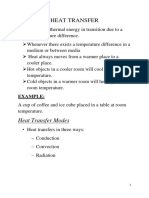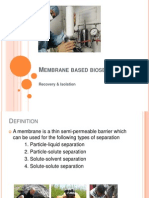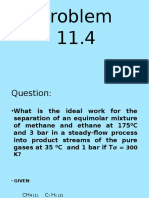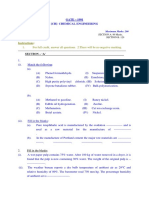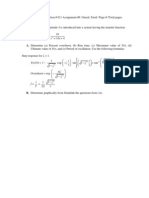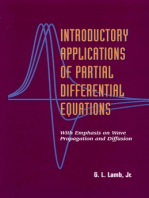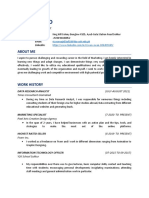0 ratings0% found this document useful (0 votes)
117 viewsChapter 2 Slide
Chapter 2 Slide
Uploaded by
canva proThis document contains 5 multi-part physics problems involving calculating heat transfer through composite walls composed of multiple layers of different materials. The problems provide the thicknesses, thermal conductivities, and surface temperatures of the materials and ask the reader to calculate values like heat flux, temperature at interfaces, thermal resistance, and rate of heat loss or flow.
Copyright:
© All Rights Reserved
Available Formats
Download as PDF, TXT or read online from Scribd
Chapter 2 Slide
Chapter 2 Slide
Uploaded by
canva pro0 ratings0% found this document useful (0 votes)
117 views15 pagesThis document contains 5 multi-part physics problems involving calculating heat transfer through composite walls composed of multiple layers of different materials. The problems provide the thicknesses, thermal conductivities, and surface temperatures of the materials and ask the reader to calculate values like heat flux, temperature at interfaces, thermal resistance, and rate of heat loss or flow.
Original Description:
This is for ITC
Original Title
Chapter 2 slide
Copyright
© © All Rights Reserved
Available Formats
PDF, TXT or read online from Scribd
Share this document
Did you find this document useful?
Is this content inappropriate?
This document contains 5 multi-part physics problems involving calculating heat transfer through composite walls composed of multiple layers of different materials. The problems provide the thicknesses, thermal conductivities, and surface temperatures of the materials and ask the reader to calculate values like heat flux, temperature at interfaces, thermal resistance, and rate of heat loss or flow.
Copyright:
© All Rights Reserved
Available Formats
Download as PDF, TXT or read online from Scribd
Download as pdf or txt
0 ratings0% found this document useful (0 votes)
117 views15 pagesChapter 2 Slide
Chapter 2 Slide
Uploaded by
canva proThis document contains 5 multi-part physics problems involving calculating heat transfer through composite walls composed of multiple layers of different materials. The problems provide the thicknesses, thermal conductivities, and surface temperatures of the materials and ask the reader to calculate values like heat flux, temperature at interfaces, thermal resistance, and rate of heat loss or flow.
Copyright:
© All Rights Reserved
Available Formats
Download as PDF, TXT or read online from Scribd
Download as pdf or txt
You are on page 1of 15
(i.e.
the rate of heat conduction in
the x-direction per unit area normal
to the x-direction)
1. An annealing chamber has a composite wall made of a 17 cm thick firebrick layer (k =
1.1 W/m °C) and a 13 cm thick ordinary brick layer (k = 0.70 W/m °C). The inside and
outside surface temperatures of the walls are 400°C and 45°C, respectively. Calculate
the heat loss from 25 m2 of furnace wall. Also, determine the temperature between the
ordinary brick and the firebrick layers.
2. The walls of a house in a cold region consist of three layers-an outer brickwork of 15 cm
thickness and an inner wooden panel of 1.2 cm thickness. The intermediate layer is made of
an insulating material 7 cm thick. The thermal conductivities of the brick and the wood
used are 0.70 W/m °C and 0.18 W/m °C, respectively. The inside and outside temperatures
of the composite wall are 21°C and -15°C, respectively. If the layer of insulation offers
twice the thermal resistance of the brick wall, calculate (a) the rate of heat loss per unit area
of the wall and (b) the thermal conductivity of the insulating material.
3. A 15 cm schedule 40 steam main carries saturated steam at 10.7 bar (gauge), and the
temperature is 190°C. The inside and outside diameters of the pipe are 15.4 cm and 16.8
cm, respectively. The thermal conductivity of the pipe wall is 51 W/m °C. The pipe is
insulated with a 10 cm thick fibre glass blanket (k = 0.072 W/m °C). If the outer surface
temperature of the insulation is 41°C, calculate the rate of heat loss over a 10 m section of
the pipe. Also, calculate the fraction of the total thermal resistance offered by the pipe
wall. Is it justified to neglect the resistance of the metal wall in this type of problem?
4. A spherical vessel of 3 m inside diameter is made of AISI 316 stainless steel sheet of 9
mm thickness (k = 14 W/m °C). The inside temperature is - 80°C. The vessel is layered with
a 10 cm thick polyurethane foam (k = 0.02 W/m °C) followed by a 15 cm outer layer of
cork (k = 0.045 W/m °C). If the outside surface temperature is 30°C, calculate (a) the total
thermal resistance of the insulated vessel wall, (b) the rate of heat flow to the vessel, (c) the
temperature and heat flux at the interface between the polyurethane and the cork layers, and
(d) the percentage error in calculation if the heat transfer resistance of the metal wall is
neglected.
5. Consider a composite wall consisting of four different materials as shown in Figure 1.
The following data are given: LA = 0.1 m, LC = 0.2 m, LD = 0.12 m, H = 2 m, HB = 1 m,
kA = 20 W/m °C, kB = 10 W/m °C, kc = 7 W/m °C, kD = 25 W/m °C, T1 = 120°C, and T2 =
50°C.
Calculate the rate of heat flow through the assembly per unit breadth. Assume one -
dimensional heat flow only. Show the electric analogue of the problem.
You might also like
- CPD Assognment CH-19048Document9 pagesCPD Assognment CH-19048Mehreen NaveedNo ratings yet
- MEHB323 Tutorial Assignment 1Document3 pagesMEHB323 Tutorial Assignment 1anirudhNo ratings yet
- Final 99 SolDocument17 pagesFinal 99 SolHungDoNo ratings yet
- 423 Problem Set 1Document2 pages423 Problem Set 1keithcrosley0% (1)
- Tutorial 1 Conduction by Prince KhanDocument8 pagesTutorial 1 Conduction by Prince KhanPrince KhanNo ratings yet
- Transport ProblemsDocument4 pagesTransport ProblemsErwin CabangalNo ratings yet
- Tutorial Heat Exchanger Sem 1 2019 2020 PDFDocument3 pagesTutorial Heat Exchanger Sem 1 2019 2020 PDFmimie azideeNo ratings yet
- HMT Unit 1Document33 pagesHMT Unit 1Alex Philip0% (1)
- Molecular Diffusion: Lecture Week 4Document25 pagesMolecular Diffusion: Lecture Week 4ashas waseemNo ratings yet
- Problems On Clausius Clayperon EqnDocument5 pagesProblems On Clausius Clayperon EqnAkshat RawatNo ratings yet
- Numerical For Practice MidtermDocument3 pagesNumerical For Practice MidtermSiddhant SinhaNo ratings yet
- Mathcad Project (ChE)Document9 pagesMathcad Project (ChE)UKissMeowNo ratings yet
- Un1 MergedDocument467 pagesUn1 MergedHariHaran KNo ratings yet
- All Tutorials ChE 313Document12 pagesAll Tutorials ChE 313Gio Albert BesaNo ratings yet
- Assignment Answer Scheme PDFDocument17 pagesAssignment Answer Scheme PDFHizami Mohammad Noor100% (2)
- Module 8: Solved ProblemsDocument11 pagesModule 8: Solved ProblemscaptainhassNo ratings yet
- Tutorial Slides - Internal Forced Convection & Natural ConvectionDocument31 pagesTutorial Slides - Internal Forced Convection & Natural ConvectionVivaan Sharma75% (4)
- Drying ProblemDocument5 pagesDrying ProblemStephanie Torrecampo Delima100% (2)
- Chapter 5 SlideDocument25 pagesChapter 5 Slidecanva proNo ratings yet
- Example Question FinalDocument22 pagesExample Question Finalgazile0% (1)
- Quiz HT105: ProblemsDocument17 pagesQuiz HT105: ProblemsZERINA ŠKULJNo ratings yet
- Lec 15Document21 pagesLec 15durgesh patelNo ratings yet
- Lec 7 Practice Problem With AnsDocument4 pagesLec 7 Practice Problem With Ansعمر الأطفيحيNo ratings yet
- ChE 61chap5mabaoDocument7 pagesChE 61chap5mabaoMichael Alex MabaoNo ratings yet
- CH4510:Process Control Lab: Dynamics of U-Tube ManometerDocument10 pagesCH4510:Process Control Lab: Dynamics of U-Tube ManometerVijay Prasad50% (2)
- 5.membrane Based Bioseparation-PurificationDocument55 pages5.membrane Based Bioseparation-Purificationobs6732100% (1)
- Learning Assessment Activity 1. QUESTIONS.: Name: Franzes Mar Eria Heat and Mass Transfer Bsche 3Document7 pagesLearning Assessment Activity 1. QUESTIONS.: Name: Franzes Mar Eria Heat and Mass Transfer Bsche 3Franzes Mar EriaNo ratings yet
- PDFDocument88 pagesPDFMuralidharanNo ratings yet
- Personal Assignment 1 - RegDocument5 pagesPersonal Assignment 1 - RegedgarNo ratings yet
- Group # 3: 4cheaDocument16 pagesGroup # 3: 4cheaNishant ChughNo ratings yet
- Heat Exchangers: DR Ali JawarnehDocument46 pagesHeat Exchangers: DR Ali Jawarnehprasanthi100% (1)
- Lesson 6Document51 pagesLesson 6Portia ShilengeNo ratings yet
- Mid-Term Exam - Thermodynamics 2Document2 pagesMid-Term Exam - Thermodynamics 2John MichaelNo ratings yet
- Tutorial 1 SolutionDocument6 pagesTutorial 1 SolutionMihir Kumar MechNo ratings yet
- Gases and Vapors (Part 1)Document2 pagesGases and Vapors (Part 1)Khristel PenoliarNo ratings yet
- General Case For Diffusion of Gases A & B Plus Bulk MovementDocument10 pagesGeneral Case For Diffusion of Gases A & B Plus Bulk MovementMayar H. HaggagNo ratings yet
- HMT Assignment 1Document6 pagesHMT Assignment 1Mahmed EdNo ratings yet
- Critical Thickness of InsulationDocument3 pagesCritical Thickness of Insulationcecilia b. guillenNo ratings yet
- ME 4241-02-Screen Analysis Screen EffectivenessDocument51 pagesME 4241-02-Screen Analysis Screen EffectivenessEric PaderNo ratings yet
- Tutorial CondensationDocument5 pagesTutorial CondensationKusmakarNo ratings yet
- 2.1. A Material Is Crushed in A Blake Jaw Crusher Such That The Average Size of Particle Is ReducedDocument1 page2.1. A Material Is Crushed in A Blake Jaw Crusher Such That The Average Size of Particle Is ReducedEduardo CarrilloNo ratings yet
- TUTORIAL-on Absorption - 2018 - SolutionDocument2 pagesTUTORIAL-on Absorption - 2018 - SolutionMayank Prasad100% (1)
- ChE23 ReportDocument10 pagesChE23 ReportPamela Mae UcabNo ratings yet
- CrystallizationDocument13 pagesCrystallizationAnonymous P1iMib50% (2)
- Chapter 03Document61 pagesChapter 03JohnJaye100% (7)
- Unsteady State Heat TransferDocument4 pagesUnsteady State Heat Transfernaser hasan fauziNo ratings yet
- Gate 1991 PDFDocument12 pagesGate 1991 PDFVammsy Manikanta SaiNo ratings yet
- Tutorial-Sums DiffusionDocument11 pagesTutorial-Sums DiffusionHridyaAshokanNo ratings yet
- MT Test 1 QPDocument2 pagesMT Test 1 QPHaribabu KrishnanNo ratings yet
- A Step Change of Magnitude 4 Is Introduced Into A System Having The Transfer FunctionDocument8 pagesA Step Change of Magnitude 4 Is Introduced Into A System Having The Transfer FunctionFarid SarrafNo ratings yet
- FreeteeDocument14 pagesFreeteemantascita100% (1)
- Gas Turbine Cycle - ProblemsDocument18 pagesGas Turbine Cycle - ProblemsharvarNo ratings yet
- Experiment 1 - Thermal Conductivity of Metal RodDocument19 pagesExperiment 1 - Thermal Conductivity of Metal RodMuskan JainNo ratings yet
- Radiation Heat TransferDocument28 pagesRadiation Heat TransferJohn Louie GresulaNo ratings yet
- 4 - Rotary DryerDocument24 pages4 - Rotary DryerkhawarNo ratings yet
- Sedimentation Finalrepz1 100604195822 Phpapp02Document6 pagesSedimentation Finalrepz1 100604195822 Phpapp02Michelle MenciasNo ratings yet
- Introductory Applications of Partial Differential Equations: With Emphasis on Wave Propagation and DiffusionFrom EverandIntroductory Applications of Partial Differential Equations: With Emphasis on Wave Propagation and DiffusionNo ratings yet
- Steady ConductionDocument4 pagesSteady ConductionSanith RenjalNo ratings yet
- Assignment - 1 HMTDocument3 pagesAssignment - 1 HMTKishore ImmanvelNo ratings yet
- Voucher-Erul WIFI-5jam-up-493-02.12.23Document9 pagesVoucher-Erul WIFI-5jam-up-493-02.12.23alkafi indraNo ratings yet
- CAT Power Generation For The Offshore Oil & Gas IndustryDocument8 pagesCAT Power Generation For The Offshore Oil & Gas IndustrymkNo ratings yet
- Install - Guide CentOS7 Warewulf PBSPro 1.3.9 x86 - 64Document61 pagesInstall - Guide CentOS7 Warewulf PBSPro 1.3.9 x86 - 64Necmettin yıldızNo ratings yet
- GoIP - SMS Server Installation Guide-20210630Document11 pagesGoIP - SMS Server Installation Guide-20210630AlexisNo ratings yet
- Internet of Things & Its ApplicationsDocument1 pageInternet of Things & Its Applicationssathishkumar sathishkumarNo ratings yet
- Eryigit Goldberg 120sDocument2 pagesEryigit Goldberg 120sElom Djadoo-ananiNo ratings yet
- 1.3 Describing Distributions With NumbersDocument45 pages1.3 Describing Distributions With Numbersctinan98No ratings yet
- Salesforce.data Cloud Consultant.v2024!10!23.q94Document62 pagesSalesforce.data Cloud Consultant.v2024!10!23.q94Tiago FernandesNo ratings yet
- Gamification Journey-A Novel Approach For Classifying Gamer Types For Gamified Educational SystemsDocument9 pagesGamification Journey-A Novel Approach For Classifying Gamer Types For Gamified Educational SystemsJaylson TeixeiraNo ratings yet
- AIC LAB Manual - Cycle 1Document30 pagesAIC LAB Manual - Cycle 1Dinesh GaikotiNo ratings yet
- Notes UNIT2 Recurrence Relations MTH401Document29 pagesNotes UNIT2 Recurrence Relations MTH401Aman KumarNo ratings yet
- Check Point GatewayDocument8 pagesCheck Point GatewayadriangrinNo ratings yet
- Spline Interpolation: ProblemsDocument17 pagesSpline Interpolation: Problemsrazlan ghazaliNo ratings yet
- Dissertation Scope and LimitationsDocument6 pagesDissertation Scope and LimitationsPaperWritingHelpCanada100% (1)
- Correlations Developed To Predict Two-Phase Flow Through Wellhead ChokesDocument10 pagesCorrelations Developed To Predict Two-Phase Flow Through Wellhead Chokesviresh196022No ratings yet
- Mitchel E Schultz Grobs Basic Electronic-56288060-253-284Document32 pagesMitchel E Schultz Grobs Basic Electronic-56288060-253-284Agnes S TandipauNo ratings yet
- High Temperature 2000C (3,632F) Laboratory Vacuum Furnace With Fast Heating Graphite Environment - For Sale - Labx Ad 4253897Document2 pagesHigh Temperature 2000C (3,632F) Laboratory Vacuum Furnace With Fast Heating Graphite Environment - For Sale - Labx Ad 4253897Salma FarooqNo ratings yet
- Telecommunication Application of DTSPDocument15 pagesTelecommunication Application of DTSPvivu_672No ratings yet
- NLP NotesDocument6 pagesNLP NotesRiya SinghNo ratings yet
- How To Build A Slayer ExciterDocument6 pagesHow To Build A Slayer ExciterKevin BinnyNo ratings yet
- Banquet Event Order Beo No. 01: Anchita@gate - Edu.npDocument2 pagesBanquet Event Order Beo No. 01: Anchita@gate - Edu.npPrateek TuladharNo ratings yet
- HTW201Document13 pagesHTW201seenubalaNo ratings yet
- Solve Business-Related Problems and To Apply Logic To Real-Life Situations. Making DecisionsDocument3 pagesSolve Business-Related Problems and To Apply Logic To Real-Life Situations. Making DecisionsEdelyn A. BergantinNo ratings yet
- 22MCC20021 Cicd 10Document3 pages22MCC20021 Cicd 1019BCA1150Pratap MukherjeeNo ratings yet
- Rizwan Sajid 2 Page CVDocument2 pagesRizwan Sajid 2 Page CVRizwanNo ratings yet
- ProctorDocument4 pagesProctorFatin HazwaniNo ratings yet
- Time-Series Extreme Event Forecasting With Neural Networks at UberDocument5 pagesTime-Series Extreme Event Forecasting With Neural Networks at UbercrackendNo ratings yet
- sgd046Document26 pagessgd046clément valleyNo ratings yet
- Ge04 EXERCISES 4Document2 pagesGe04 EXERCISES 4Alvin Sy EnricoNo ratings yet
- WH Brady Electric Hoist PDFDocument4 pagesWH Brady Electric Hoist PDFSuresh NathNo ratings yet







